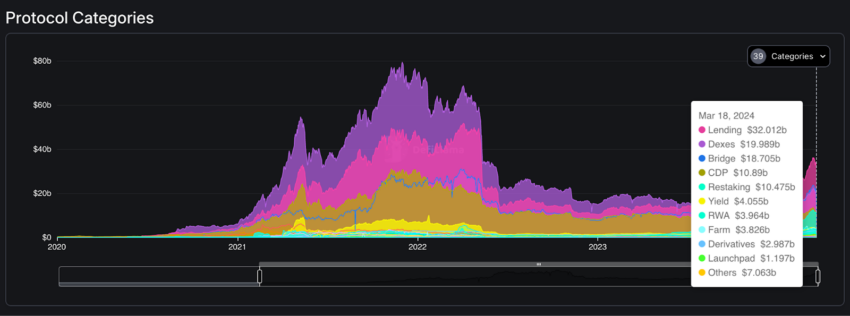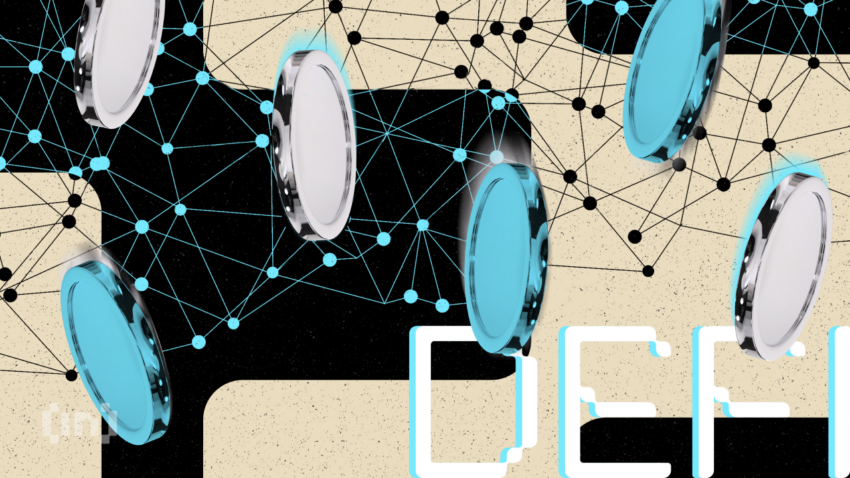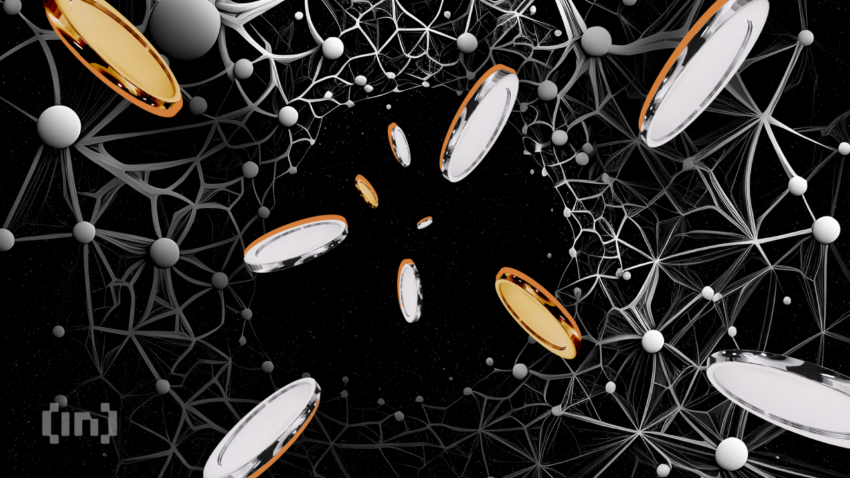Als de traditionele financiële wereld een blockchain make-over zou krijgen, zouden DeFi-protocollen onvermijdelijk het resultaat zijn. Hier heersen gedecentraliseerde apps (DApps) en slimme contracten die je controle bieden over je financiële toekomst.
Van het staken van je digitale assets voor crypto-opbrengst tot het uitvoeren van anonieme crypto-swaps, deze gids laat je kennismaken met de top DeFi-protocollen om in de gaten te houden in 2025.
Methodology
BeInCrypto evaluated several leading protocols to determine the top offerings in 2025.
We based our evaluation on certain key criteria, looking for reputable protocols offering secure and user-friendly experiences. The following DeFi protocols were selected after a six-month testing period. Here’s how each stood out during our testing.
PancakeSwap:
Offers low transaction fees compared to other DEXs, appealing to frequent traders.
Provides a wide range of features including yield farming, lotteries, and NFTs, which enhances user engagement.
Operates on Binance Smart Chain for fast and efficient transactions, suitable for a broad user base.
Uniswap:
Pioneered the AMM model, providing high liquidity and enabling direct wallet-to-wallet trading.
Offers wide token support, facilitating access to a vast array of ERC-20 tokens.
Strong community and open-source nature ensure continuous improvements and transparency.
Curve:
Specializes in stablecoin swaps with minimal slippage, optimizing user investments.
High liquidity pools and low fee structure improve user trading experience.
Integrates advanced cryptographic methods, enhancing security and efficiency.
Balancer:
Offers customizable liquidity pools, allowing users to create pools with up to eight different tokens.
Acts as a self-balancing weighted portfolio and price sensor, automating portfolio management.
Provides high flexibility in defining pool parameters, catering to varied user preferences.
Summer.fi (previously Oasis.app):
Provides an intuitive interface for seamless DeFi interactions, suitable for beginners.
Offers various DeFi products and automation features for a holistic experience.
Prioritizes user control and transparency, aligning with the core principles of DeFi.
Aave:
Offers innovative features like flash loans for quick, uncollateralized borrowing.
Incorporates a range of interest rate options, catering to different risk appetites.
Utilizes a decentralized governance structure, ensuring community-driven development.
MakerDAO:
Provides a stable and reliable DAI stablecoin pegged to the U.S. dollar, reducing volatility.
Features a robust governance system allowing MKR token holders to vote on critical decisions.
Offers multi-collateral vaults, providing users with flexibility in collateral choices.
Compound:
Allows users to earn interest on deposited cryptocurrencies and borrow against them.
Implements an autonomous interest rate protocol, adjusting rates based on market demand.
Features a transparent, open-source interface that encourages user trust and security.
dYdX:
Specializes in decentralized margin trading, derivatives, and perpetual contracts for advanced traders.
Offers layer=2 scaling solutions, providing fast and cost-effective transactions.
Employs a hybrid model combining off-chain order books with on-chain settlements, enhancing trading speed and efficiency.
Lido:
Provides liquid staking solutions, allowing users to earn staking rewards without locking assets.
Supports multiple blockchain networks, expanding user options for staking different cryptocurrencies.
Implements decentralized and non-custodial services, promoting security and user control.
De.Fi:
Delivers comprehensive DeFi platform scanning for vulnerabilities, enhancing user security.
Offers real-time monitoring of user wallets and transactions, ensuring transparency and control.
Provides a range of investment tools and features for an informed DeFi experience, catering to various user needs.
Overall, these DeFi protocols were selected based on their unique features, security measures, and ability to offer a user-friendly experience. Each protocol stands out for its innovative solutions to common DeFi challenges such as liquidity, security, and accessibility, making them top choices in the current DeFi landscape. By addressing the needs of a diverse range of users, from beginners to advanced traders, these protocols are shaping the future of decentralized finance, making it more accessible, efficient, and secure for everyone.
For further insight into BeInCryto’s verification methodologies, click here.
11 De beste DeFi-protocollen in 2025.
Beste gedecentraliseerde exchanges (DEXs) protocollen
1. PancakeSwap
PancakeSwap a top-tier DeFi protocol. It focuses on the Binance Smart Chain blockchain, but supports a total of eight networks, including Ethereum.
PancakeSwap’s native crypto is CAKE, which has a total supply of 450 million tokens. This decentralized exchange leverages an automated market maker (AMM) model, allowing for direct, wallet-to-wallet trades without intermediaries, enhancing user control and security.
Moreover, it offers a range of services beyond simple trades, such as yield farming, staking, and lotteries, enabling users to earn rewards in various ways. Its user-friendly interface makes it accessible for beginners, while its innovative features, like the zkBridge technology, ensure secure and efficient transactions across different blockchain networks.
PancakeSwap’s growth is underscored by its status as the first billion-dollar project on the Binance Smart Chain and its continual upgrades, such as the current PancakeSwap V3, demonstrating its commitment to improving functionality and user experience.
- Intuitive interface
- High APY for liquidity providers (LPs)
- Supports staking and farming
- NFT marketplace
- No mobile app
- No native crypto wallet
Trade features: Instant crypto trading, liquidity pools, asset bridging, perpetual trading, and cryptocurrency purchasing.
Earning features: Farming, pools, liquid staking, simple staking.
Game and NFT features: Gaming marketplace, prediction market, NFT marketplace for NFTs on BNB Chain.
DeFi and ecosystem engagement: Governance, initial farm offerings (IFOs), gauge voting and revenue sharing, and farm booster.
2. Uniswap
Uniswap is another leading decentralized exchange. The native token is UNI, which has a total supply of 1 billion tokens.
Governed by its users through the UNI token, it offers a community-driven experience, unlike centralized platforms. Uniswap’s liquidity pools facilitate secure and direct token swaps, ensuring users maintain complete control over their funds. Originally built on Ethereum, it now supports other Ethereum-compatible networks like Polygon and Optimism, offering lower transaction costs.
Uniswap’s simplicity makes it accessible for beginners while providing advanced features for experienced users. This is rare when it comes to DEXs, which can often be tricky to use and less straightforward than their CEX counterparts. Uniswap also boasts broad token availability and deep liquidity, reducing price impact on large trades.
Additionally, the DEX has integrated NFT trading, enhancing its offerings. With nearly 5 million unique wallet addresses and surpassing $1 trillion in trading volume, its popularity and reliability are evident.
Finally, Uniswap’s swap fees are competitive, especially when compared to centralized exchanges, and users can choose cheaper networks to avoid high Ethereum gas fees.
- Easy-to-use interface
- Low-cost trades
- Multiple blockchain networks supported
- No mobile app
- High fees when purchasing crypto (third-party services)
Trade features: Instant crypto trading, liquidity pools, asset bridging, cryptocurrency purchasing.
Earning features: Funding liquidity pools, swap fee earnings.
Game and NFT features: NFT marketplace, prediction market.
DeFi and ecosystem engagement: Governance, concentrated liquidity, transaction fee structure.
3. Curve Finance
Curve Finance is a leading decentralized exchange (DEX) on the Ethereum blockchain, specializing in the efficient trading of stablecoins and wrapped tokens like wBTC, renBTC, and sBTC. Founded by Michael Egorov, it has quickly risen to prominence, and is particularly famed for its innovative use of liquidity pools and automated market maker (AMM) systems. These allow users to earn high annual interest rates — over 300% in some pools — on deposited cryptocurrency.
The platform distinguishes itself with its unique bonding curve. This is optimized for stablecoins to reduce slippage, allowing significant trades with minimal price impact. This has positioned Curve as a vital component in the DeFi space, especially for those interested in liquidity mining and yield farming.
Curve Finance operates as a decentralized autonomous organization (DAO), with its governance token CRV enabling holders to vote on changes and proposals. This shift to a DAO structure allows Curve to operate with enhanced transparency and community-driven development. Despite its complexity and the potential for impermanent loss, Curve Finance offers significant opportunities for liquidity providers and traders, underlined by robust security measures including multiple code audits and bug bounties to safeguard user assets.
- Specializes in stablecoins
- Reduced slippage
- Governed by DAO
- Multiple security audits
- Bug bounties for added safety
- Complex for beginners
- Focused mainly on stablecoins and wrapped tokens
- Reliance on Ethereum blockchain, leading to potential high gas fees
Trade features: Stablecoin specialization, efficient liquidity pools, unique bonding curve, minimal slippage in trades.
Earning features: High annual interest rates from liquidity pools, rewards in CRV tokens, participation in yield farming.
Security features: Multiple security audits, bug bounties, governed by decentralized autonomous organization (DAO).
DeFi and ecosystem engagement: Governance via CRV token, high total value locked (TVL), support for various wrapped tokens.
4. Balancer
Balancer is a versatile and innovative DeFi platform that redefines the concept of decentralized exchanges (DEXs) by combining elements of automated market makers (AMMs) and index funds.
Unlike traditional DEXs — which typically focus on two-token liquidity pools — Balancer’s USP lies in its ability to maintain a balanced portfolio through automatic rebalancing, adjusting the pool’s asset allocations in response to market price changes.
Balancer supports three types of pools: public pools, where anyone can add liquidity and earn trading fees; private pools, where only the creator can contribute liquidity and set parameters; and smart pools, which are private pools with adjustable parameters controlled by a smart contract. This flexibility caters to a wide range of user preferences and risk tolerances.
Furthermore, Balancer’s architecture is designed to function not only on Ethereum but also on six additional blockchain networks, expanding its accessibility and interoperability within DeFi ecosystems. By providing a decentralized platform for multi-asset liquidity, Balancer contributes significantly to the efficiency of the cryptocurrency market.
- Multi-token pools
- Automated rebalancing
- Interoperability
- Complex for beginners
- Limited on smaller chains
Trade features: Multi-token pools, automated portfolio rebalancing, customizable pool types (public, private, smart), wide asset variety, minimal slippage through dynamic trading fees.
Earning features: Rewards in BAL tokens, high yield from liquidity provision, participation in liquidity mining, diversified income streams through various pool types.
Security features: Regular security audits, bug bounty programs, non-custodial asset management, transparent smart contract operations.
DeFi and ecosystem engagement: Governance via BAL token, significant total value locked (TVL), interoperability across multiple blockchains, support for a variety of digital assets and wrapped tokens.
Beste DeFi-protocollen voor lenen en uitlenen
5. Summer.fi
Summer.fi, initially known as Oasis.app and one of the earliest MakerDAO projects from 2016, has evolved significantly beyond its original scope.
After Maker became fully decentralized, Summer.fi emerged as a standalone platform, dedicated to establishing a highly trusted application for DeFi capital deployment.
It now transcends being merely an interface for the Maker Protocol. It aims to be the most secure place for engaging with DeFi, providing users with advanced automation features like stop-loss, auto-buy, and auto-sell, as well as strategies such as a Constant Multiples for optimizing Vault performance. If your Vault’s collateralization ratio hits your Sell Trigger, Constant Multiple will execute.
Summer.fi prioritizes user experience, offering clear insights into positions, returns, and associated risks, backed by a comprehensive knowledge base reflecting community feedback.
- Comprehensive DeFi services
- Advanced automation features, (stop-loss, take-profit, auto-buy, etc.)
- User-friendly interface
- Integration with multiple protocols (Aave and Maker)
- Complex for new users
- Limited to ERC-20 tokens
Borrowing features: Flexible repayment schedules, diverse collateral types, integrated with multiple protocols like Aave and Ajna, protection against market volatility through the Oracle Security Module and constant updates from Chainlink.
Multiplying features: Increase or decrease collateral exposure in one transaction, use borrowed funds to buy more collateral, integration with liquid platforms and the 1inch DEX aggregator for best execution prices, dedicated interface for managing positions.
Earning features: Self-custody solutions for yield earning, compatibility with Aave and Maker protocols, increase yield from StETH, participate in the Dai Savings Rate for passive income.
Automation features: Stop-loss to prevent liquidations, take-profit for efficient exits, auto-buy and auto-sell for Vault management, Constant Multiple to maintain predefined exposure levels.
Integration and partnerships: Support for various wallets like MetaMask and Ledger, integration with the 1inch Network for efficient token swaps, launched on Optimism layer-2 for reduced transaction costs, Ajna Protocol integration for curated borrowing and lending pools.
6. Aave
Aave (AAVE) is a pioneering entity in the DeFi sector. The comprehensive lending platform boasts a significant Total Value Locked (TVL), which surpasses $10 billion in crypto collateral.
Aave enables users to lend and borrow a wide array of tokens across multiple ecosystems, ensuring a versatile and inclusive financial experience.
The platform’s latest iteration, Aave V3, expands its reach beyond Ethereum to include 10 different blockchain networks, further solidifying its position as a key player in the DeFi landscape by enhancing accessibility and providing a range of options for its diverse user base.
- High TVL
- Wide range of tokens
- Multi-chain accessibility
- Flash loans availability
- Governance via AAVE token
- Complexity for beginners
- High gas fees on Ethereum
- Risk of liquidation
Trade features: Flash loans, real-time interest accrual, stable and variable interest rates, Ethereum network integration, multi-asset collateral support.
Earning features: aTokens for deposit interest, decentralized lending and borrowing, yield optimization strategies, liquidity mining.
Security features: Over-collateralization of loans, smart contract audits, safety module for risk mitigation, bug bounties for platform integrity.
Platform and ecosystem features: Governance via AAVE tokens, layer-2 solutions for reduced fees, decentralized autonomous organization (DAO) structure, no KYC requirements, multi-chain accessibility.
7. MakerDAO
MakerDAO is a pioneering DeFi platform that has revolutionized the way users engage with digital assets. The platform provides a decentralized borrowing and lending system with its stablecoin, DAI, at the core.
Built on the Ethereum blockchain, it allows users to leverage a variety of cryptocurrencies as collateral to generate DAI, maintaining stability through rigorous governance by MKR token holders.
The platform distinguishes itself with features like over-collateralization to ensure loan security, and a dual-rate model offering users the choice between stable and variable interest rates. Despite its innovative approach, users must navigate complexities such as liquidation risks and market volatility.
As MakerDAO evolves, it continues to solidify its status as a cornerstone of the DeFi landscape with the introduction of upgrades like V3 and the addition of the GHO stablecoin — balancing user empowerment with the intricate dynamics of decentralized finance.
- Decentralized lending
- DAI stability
- Ethereum-based
- Governance by MKR
- Over-collateralization
- Variable interest rates
- Complexity
- High gas fees
- Liquidation risks
Trade features: Flash loans, stable and variable interest rates, real-time aTokens, multi-currency collateral, governance-driven updates.
Earning features: Interest on deposits, participation in governance, yield farming opportunities, dynamic interest rates.
Security features: Over-collateralization, liquidation mechanisms, community governance for risk management, security modules for asset protection.
Platform and ecosystem features: Decentralized borrowing and lending, Ethereum-based, MKR token for governance, integration with multiple crypto assets, open-source development, Maker Vaults for asset management.
8. Compound Finance
Compound Finance is a prominent decentralized lending platform operating on the Ethereum blockchain, known for pioneering the DeFi lending space.
Established by Robert Leshner and Geoffrey Hayes in 2018, Compound simplifies the process of borrowing and lending cryptocurrencies without intermediaries, allowing over $2 billion in assets to be locked on its platform.
Unique for its innovations, such as yield farming and governance through COMP tokens, the platform aims to provide financial inclusion, eliminating traditional transaction minimums and credit checks.
While offering competitive returns through real-time interest rates, users engaging with Compound and its governance token, COMP, must be cautious of market volatility and conduct in-depth research prior to investment.
- Decentralized borrowing and lending
- No transaction minimums
- User-friendly interface
- Supports multiple ERC-20 assets
- Yield farming opportunities
- Market volatility risks
- Requires over-collateralization
- Complexity for new users
- High gas fees on Ethereum
Trade features: Real-time interest rate adjustments, supports diverse ERC-20 tokens, user-centric lending and borrowing system.
Earning features: Yield farming with COMP tokens, competitive APR for lenders, dynamic interest rates based on market conditions.
Security features: Extensive security audits (Trail of Bits, OpenZeppelin), economic risk analysis by Gauntlet, transparent and verifiable contracts.
DeFi and ecosystem engagement: Decentralized governance with COMP tokens, financial inclusion without traditional verifications, continuous platform innovation and updates.
Beste DeFi-protocollen voor liquid staked
9. dYdX
The dYdX protocol provides advanced financial instruments like perpetual and margin trading within the DeFi ecosystem. The leading exchange operates without KYC, allowing for anonymous, trustless trading. It supports perpetual and margin trading, alongside lending and borrowing, and offers competitive fee structures and gas-free trading experiences.
The platform provides lower collateralization levels compared to competitors, increasing accessibility. dYdX also utilizes StarkWare for increased efficiency and lower transaction fees and allows for community contributions and governance.
Notably, dYdX also transitioned to an independent blockchain within the Cosmos ecosystem, enhancing performance and furthering decentralization.
- Advanced trading options
- No KYC required
- Low fees
- Layer-2 scalability
- Dynamic interest rates
- Interoperability with Cosmos
- Complex for beginners
- Dependent on Ethereum
- Limited spot trading
- New chain transition challenges
- Ecosystem adaptation required
Trade features: Perpetual trading, margin trading, decentralized order book, layer-2 scalability, cross-margin capabilities.
Earning features: Lending, borrowing, dynamic interest rates, trading rewards.
Security features: Self-custodial security, third-party audits, secured by Ethereum protocol.
Platform and ecosystem features: No KYC, open-source code, integration with Cosmos ecosystem, decentralized governance, off-chain order matching.
10. Lido
Lido Finance is an innovative DeFi staking protocol offering user-friendly, semi-custodial staking services across multiple cryptocurrencies. Known for its simple interface and decentralized structure, Lido allows users to stake their assets and receive liquid staking tokens, such as stETH, which can be utilized in the broader DeFi ecosystem for yield farming.
Supported by major players in DeFi and endorsed for its reasonable fees and rewarding referral program, Lido maximizes decentralization through its governance token, LDO, allowing stakeholders to partake in decision-making. While Lido streamlines the staking process, users should consider the semi-custodial nature, the staking rewards fees, and potential tax implications associated with rewards.
- User-friendly interface
- Liquid staking tokens
- Decentralized governance
- Supported by DeFi leaders
- Semi-custodial service
- Staking rewards fees
- Potential tax implications
Staking features: Easy and unrestricted staking, maximized earning potential, liquid staking tokens for yield farming.
Earning features: Daily staking rewards, assets used as collateral for lending and yield farming, participation in governance for reward optimization.
Security features: Smart contracts audited by Quantstamp and Sigma Prime, semi-custodial nature maintains user control.
DeFi and ecosystem engagement: Governance via LDO tokens, broad DeFi integration, supports multiple blockchains including Ethereum, Solana, Kusama, Polkadot, and Polygon.
Beste DeFi-protocol voor portefeuillebewaking
De.Fi provides detailed smart contract analysis to detect potential vulnerabilities and assign security scores. It offers an extensive dashboard for monitoring wallet transactions and balances, alongside powerful investment tools for analyzing and controlling positions in DeFi protocols, NFT collections, and lending markets.
Additionally, De.Fi includes specialized security features like the De.Fi Shield and Scanner for thorough contract examination. It also comes with user-friendly transaction tools such as secure crypto sending and De.Fi Swap for easy cryptocurrency exchanges across various blockchains, making it a well-rounded solution for navigating the DeFi space safely and effectively.
- Advanced security scanning
- Comprehensive dashboard
- Real-time analytics
- User-friendly interface
- Multi-blockchain support
- Complexity for beginners
- Technical knowledge needed
- Frequent updates required
Smart contract and security features: Vulnerability scanning, smart contract security scoring, De.Fi Shield, De.Fi Scanner.
Portfolio and transaction monitoring features: Comprehensive dashboard, address book, wallet balance tracking, deposited and loaned balances overview.
Investment and exploration features: Market analysis tools, NFT portfolio management, exploration of DeFi opportunities.
Security and protection tools: Asset security assessments, approval checks, risk highlights for tokens and NFTs, customizable security settings.
Transaction and exchange features: Secure cryptocurrency sending, De.Fi Swap, slippage tolerance settings.
DeFi-protocollen vergeleken
| Protocol | Type | TVL | Token | # ondersteunde blockchains |
| PannenkoekWissel | DEX | $2.224B | CAKE | 9 |
| Uniswap | DEX | $5.543B | UNI | 8 |
| Curve | DEX | $2.486B | CRV | 14 |
| Balancer | DEX | $1.242B | BAL | 8 |
| Zomer.fi | DEX | $5.345b | zomer.fi | 4 |
| Aave | Lenen | $10.564B | AAVE | 12 |
| MakerDAO | Kredietverlening | $7B | MKR | 1 |
| Samengesteld | Lenen | $2.668B | COMP | 4 |
| dYdX | DEX | $401.81M | dYdX | 1 |
| Lido | Staked | $34.445B | LDO | 5 |
| De.Fi | Tracker en Wallet | n.v.t. | DEFI | 15 |
Wat zijn DeFi-protocollen?
DeFi-protocollen zijn reeksen regels, procedures en codes voor gedecentraliseerde financiële (DeFi) systemen, die gebruikers in staat stellen activiteiten te ontplooien zoals handelen, lenen en tokens staken binnen blockchain-ecosystemen.
DeFi vertegenwoordigt een paradigmaverschuiving die gebruik maakt van blockchaintechnologie, voornamelijk Ethereum, om een open, toestemmingsvrij en grenzeloos financieel ecosysteem te cultiveren. In tegenstelling tot traditionele systemen schrijven ontwikkelaars smart contracts om DeFi-protocollen te implementeren die peer-to-peer interacties zonder tussenpersonen mogelijk maken. Door zich aan dezelfde set regels te houden, zorgen DeFi-protocollen voor een gestandaardiseerde ervaring voor alle deelnemers.
Een voorbeeld van een DeFi-protocol is MakerDAO. Het populaireDeFi-uitleenplatform stelt gebruikers in staat te lenen tegen hun crypto-assets door ze vast te zetten in ruil voor een stablecoin, DAI, en biedt zo meer voorspelbare terugbetalingstermijnen ondanks de volatiliteit van de cryptomarkten.
Andere protocollen stellen je in staat om een passief inkomen te verdienen door rendement te genereren uit je staked assets. Een populair voorbeeld is het Lido protocol, waarmee je kunt verdienen aan stETH. Platformen zoals Lido streven ernaar de hoogste APY te bieden op crypto staking, waardoor gebruikers het rendement op hun staked assets binnen het Ethereum ecosysteem kunnen maximaliseren.
De totale vergrendelde waarde (TVL) wordt vaak gebruikt als een metriek om de adoptie en het nut van een protocol te meten, met MakerDAO als een van de grootste door TVL, wat zijn sterke rol in het DeFi-landschap benadrukt.
In 2025 evolueren protocollen en blockchains en worden nieuwe en efficiëntere technologieën ontwikkeld. Sommigen integreren bijvoorbeeld asynchrone smart contracts, waarmee transacties en overeenkomsten kunnen worden uitgevoerd zonder dat alle partijen tegelijkertijd aanwezig of online hoeven te zijn. Dit helpt bij het stroomlijnen van operaties binnen netwerken zoals Ethereum.
Volgens DeFiLlama zijn de belangrijkste protocolcategorieën leningen, DEX’en, bridges, CDP (protocollen die hun eigen stablecoin slaan met behulp van collateralized lending) en restaking.

Waarom heb je DeFi-protocollen nodig?
Met DeFi kunnen gedecentraliseerde apps (DApps) en platforms diensten aanbieden zoals crypto uitlenen en crypto-opbrengst verdienen door middel van staking. Gebruikers kunnen deelnemen aan AMM-systemen(automated market maker) voor verbeterde liquiditeit.
Deze functies bieden een vruchtbare bodem voor startups om verder te innoveren dan algemene financiële producten, wat snelle experimenten en potentiële disruptie bevordert. De wereldwijde toegankelijkheid van DeFi-platforms maakt ze tot een sterke tool voor financiële inclusie, waardoor startups een wereldwijd publiek kunnen bereiken.
De interoperabiliteit tussen verschillende DeFi-protocollen versterkt dit nog verder, waardoor naadloze integratie van diensten zoals web3 gaming en metaverse tokens mogelijk wordt, waardoor het bereik van wat blockchain-startups kunnen bereiken wordt vergroot.
De totale vergrendelde waarde (TVL) in DeFi-platforms dient als een metriek van vertrouwen en nut en geeft het aantal gestakete, uitgeleende of aan liquiditeitspools toegewezen cryptocurrencies aan, wat de groei en stabiliteit van het ecosysteem benadrukt.
Door het elimineren van tussenpersonen verlaagt DeFi de transactiekosten sterk, waardoor het een aantrekkelijk model is voor startups, vooral op het ontluikende gebied van cryptoleningen en het genereren van rendement. In plaats van je zorgen te maken over je kredietscore, kun je een cryptolening aanvragen met minder beperkingen dan bij TradFi. Deze verlaging van de kosten, gecombineerd met het potentieel voor high crypto-opbrengst door mechanismen zoals staked, positioneert DeFi als een steeds populairdere optie voor zowel ondernemers als investeerders in de cryptomarkt.
Hoe werken DeFi-protocollen?
DeFi protocollen werken door gebruik te maken van blockchaintechnologie. De meeste zijn gebaseerd op Ethereum, maar sommige ondersteunen ook andere netwerken. De kern van deze diensten zijn smart contracts, zelfuitvoerende contracten met de voorwaarden van de overeenkomst rechtstreeks in code geschreven, die de onderhandeling of uitvoering van een contract vergemakkelijken, verifiëren en afdwingen.
DeFi vereist echter grondig onderzoek en inzicht in verschillende factoren, waaronder security, liquiditeit en de bestuursstructuur van het platform. Het is belangrijk om de gebruikerservaring, de mate van interoperabiliteit met andere DApps en blockchain-systemen en de mate van betrokkenheid van de community bij besluitvormingsprocessen te beoordelen.
1. Gedecentraliseerde apps (DApps)
Gebruikers kunnen gebruik maken van verschillende DeFi-platforms of DApps om toegang te krijgen tot een breed scala aan financiële diensten.
Een veelgebruikte manier om deel te nemen is via cryptoleningen op platformen. Met protocollen zoals Aave of Compound kun je cryptocurrencies storten om rente te verdienen. De verdiensten worden gemeten als Annual Percentage Yield (APY), wat een volatiel percentage is dat overeenkomt met de vraag van de markt.
2. Liquidity mining
Een andere populaire DeFi-activiteit is liquidity mining. Je kunt liquiditeit bieden aan gedecentraliseerde exchanges (DEX’en) door je assets te storten in liquiditeitspools. Deze storting wordt meestal gedaan voor een paar assets, zoals ETH-USDT, maar het kan van alles zijn.
In ruil daarvoor verdien je beloningen, vaak in de eigen tokens van het platform. Dit proces is van cruciaal belang om ervoor te zorgen dat er genoeg marktliquiditeit is voor de handel en wordt vergemakkelijkt door AMM’s, algoritmes die door DEX’en worden gebruikt om de koers van tokens te bepalen en transacties te vergemakkelijken.
3. Swaps (handel)
Handelen op DEX’en is een andere belangrijke functie van DeFi-protocollen. Deze platformen stellen gebruikers in staat om cryptocurrencies rechtstreeks met anderen te verhandelen op een meer private en toegankelijke manier dan op gecentraliseerde exchanges.
Dit ondersteunt niet alleen het gedecentraliseerde ethos van blockchain, maar draagt ook bij aan de Total Value Locked (TVL).
Moet u DeFi-protocollen gebruiken?

Voordelen
- Geld verdienen: Je kunt je crypto voor je laten werken. Plaats je assets in DeFi-platforms om rente of beloningen te verdienen.
- Handel gemakkelijk: Ruil cryptocurrencies rechtstreeks met anderen. Geen tussenpersoon nodig.
- Meer controle: Jij bent de baas over je geld. Geen enkele bank of instelling kan jouw transacties blokkeren.
- Open voor iedereen: Iedereen met een internetverbinding kan meedoen. Het is wereldwijd en inclusief.
- Transparant: Alles wordt vastgelegd op de blockchain. Je kunt alle transacties zien.
- Nieuwe mogelijkheden: Verken nieuwe financiële diensten zoals crypto lending of web3 gaming.
Nadelen
- Riskant: Cryptowaarden kunnen snel veranderen. Je investeringen kunnen snel slinken.
- Ingewikkeld: Sommige DeFi dingen zijn moeilijk te begrijpen. Het is niet altijd beginnersvriendelijk.
- Security problemen: Hacks gebeuren. Als een DeFi-platform wordt aangevallen, kunt u uw geld verliezen.
- Geen klantenservice: Als u een probleem heeft, is er geen klantenservice die u kunt bellen.
- Onderzoek nodig: Je moet je huiswerk doen voordat je investeert. Niet alle platforms zijn veilig.
- Hoge kosten: Soms betaal je veel voor transacties, vooral als het netwerk druk is.
Kan DeFi traditionele financiën vervangen?
Decentrale financiering heeft het potentieel om traditionele instellingen, met name TradFi, over te nemen. Decentrale financiering stelt gebruikers in staat om veilig, anoniem en efficiënt transacties te doen en zal dus waarschijnlijk aan populariteit winnen naarmate het gebruik van web3 en crypto groeit. Van crypto lending tot staked tot market makers, DeFi is opwindend, voortdurend in ontwikkeling, maar ook riskant.
Ga pas aan de slag met DeFi-protocollen als je een solide plan hebt ontwikkeld en volledig vertrouwd bent met de mechanismen van het platform. Wees u altijd bewust van de kans op verlies en investeer nooit meer dan u zich kunt veroorloven te verliezen.
Veelgestelde vragen
What is the most popular DeFi protocol?
What are the top five DeFi tokens?
What is TVL in DeFi protocols?
How many DeFi protocols are there?
How many DeFi protocols are there?
Is TVL a good metric?
What is a good FDV TVL ratio?
What is the TVL formula?
How to calculate FDV?
Disclaimer
Alle informatie op onze website wordt te goeder trouw en uitsluitend voor algemene informatiedoeleinden gepubliceerd. Elke actie die de lezer onderneemt op basis van de informatie op onze website is strikt op eigen risico.




